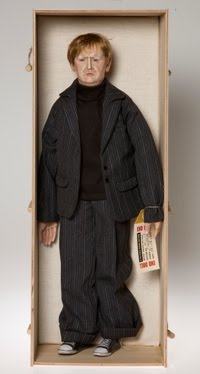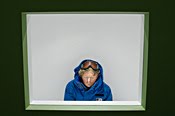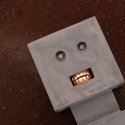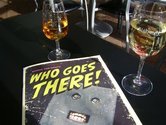John Hurrell – 27 September, 2009
That's the wonderful thing about these projects, that nursery-tales, old movies, inner anxieties and prosaic imagery all get jumbled up together.
Ronnie van Hout
Who goes there?
Curated by Justin Paton
4 July - 18 October 2009
This Ronnie van Hout show is an updated extension of the earlier survey I’ve Abandoned Me, also put together by Justin Paton (in 2003) when he worked in Dunedin. That show when it toured, didn’t come to Christchurch, the artist’s home town. (He’d since shifted to Melbourne). This supplement (containing only one work from I.A.M.) is very focused, examining as before the artist’s exploration of interiority, weaving and ducking inside and out his Private Self (or Selves) - and its twin Public Persona. This is exemplified by the artist in an eponymous video knocking on his front door and waiting for himself to answer. Flicking backwards and forwards between public and private.
The similes in this display are quite tight (literally and figuratively). As coverers (or containers) of the van Hout body there are lots of buildings, kennels, doorways, cupboards, box-shaped robots, igloo-shaped museum dioramas, gallery walls and coffins. They have one thing in common. They all use flat wooden sheets that are thin and vulnerable, and that ‘skin’ provides physical and psychic protection from the invasive machinations of aliens, hostiles creatures dwelling inside speaking animals, other van Houts, or perhaps the art public.
Some of most memorable images feature parts of finely detailed, Ronnie van Hout dolls, initially produced for an edition at The Physics Room. Two small robots sitting on giant beds, seem to be waiting for Goldilocks and The Three Bears, while another display of ten identical Ronnies stashed in coffins appears to reference the story of Dracula invading England in a ship.
That’s the wonderful thing about these projects, that nursery-tales, old movies, inner anxieties and prosaic imagery all get jumbled up together. The most normally forgettable event suddenly acquires meaning by being recontextualised.
Sometimes inner and outer elements are not jumbled up but only juxtaposed - like in the Antarctica project where a sculpture of the seated artist makes him look withdrawn and self conscious, similar to a forlorn animal gazed upon in a zoo, whereas the nearby videos show him as gregarious and outgoing, taking an interest in what other people in Scott Base are up to.
Then there is the complicated matrix of various sub-themes, like his digging of escape tunnels as if to get away from his Self, to avoid being spied upon, to also avoid being the subject matter of art and its nosy audience.
A lot of the show makes jokes about gallery strategies of viewer manipulation, and how to thwart the gallery visitor (such as when a electric-eye activated voice warns them not to touch certain exhibits), or perversely to tease her or him with intimate peepshows.
More pronounced are jokes about the activities of gallery education officers striving to get children involved with the exhibits. Many of the wall works and certainly the show’s catalogue duplicate the questions and puzzles teachers give classes when they visit galleries. The enthusiastic art lover is deliberately treated like a child in a manner that just stops short of being insulting.
This aspect ties in nicely with van Hout’s interest in his own education, specifically at Mairehau High in Christchurch. He has a large wooden model of the main classroom, with wee videos of himself peering out the windows restless and irritable as if being a prisoner - while the curious gallery visitor is in turn watched by a surveillance camera (a form of artist’s revenge). Photographs of smaller models of the school and his family home (there is also a bigger wooden model of that) are positioned nearby.
Who goes there? is not as impressive as I’ve Abandoned Me which was much wider in scope (for example it had great embroidery and concrete paintings), and had a superb catalogue of writing from Paton - but it is immensely interesting all the same. It is unusual in the way it examines the art institution from the point of view of an artist normally associated with jokes stemming from a brooding anxiety, who despite his successful career has gnawing reservations about what he is doing there.
The title thus applies to himself. Who goes there? also applies to the gallery visitor whom he treats like an invader. The title asks you to declare your identity, if you are confident you have one, and why have you come. What on earth are you doing in this building?







 Advertising in this column
Advertising in this column Two Rooms presents a program of residencies and projects
Two Rooms presents a program of residencies and projects



This Discussion has 0 comments.
Comment
Participate
Register to Participate.
Sign in
Sign in to an existing account.